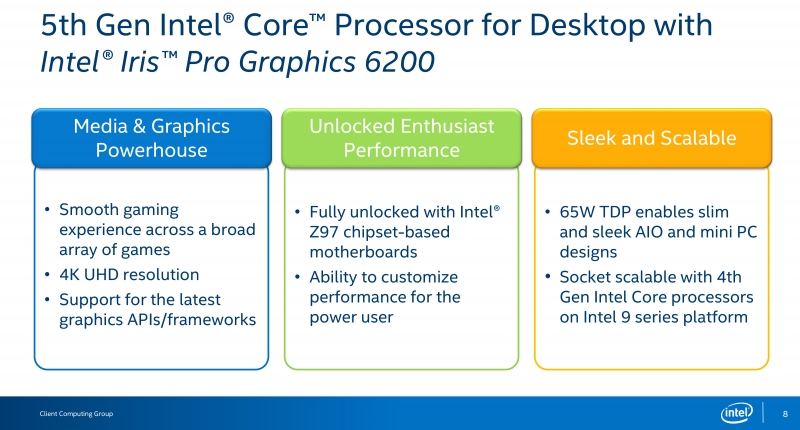A Rough But Promising Release
The arrival of Intel's 5th generation Core processors has been heavily delayed, but now that we are starting to get our first look at Broadwell, it seems there are still issues with the 14nm node. For starters, Intel has only announced two socketed CPUs, a single Core i7 and a Core i5.
Nothing for the Core i3 range has been announced yet, which is unlike Intel. It is also unlike Intel to come out with such a staggered release. By which we mean you still can't really get your hands on a new Core i7 or Core i5 processor yet. In fact, availability isn't supposed to improve until sometime in August.
So with just two socketed Broadwell CPUs on offer, what can consumers expect? Admittedly, the Core 5775C didn't look great in our tests and that's a shame, because we believed it to be a rather impressive processor.
It is important to keep in mind that the 5775C's base clock speed is 18% lower than that of the 4790K, while the Turbo clock is 14% lower. This in itself is a disappointment, though both processors are fully unlocked so stock frequencies don't matter very much.
That said, the 5775C couldn't even be overclocked to match the maximum Turbo frequency of the 4790K which is 4.4GHz (at least our sample couldn't be, anyway). Just to get the CPU stable enough at 4.2GHz for testing we had to feed it quite a lot of extra voltage.
This means that out of the box, the raw performance of the 5775C won't often impress, while its overclocking potential at this point is also pretty abysmal.
Where the 5775C shines is in its 3D performance, and we hope AMD has been taking note. The Iris Pro 6200 makes the 5775C the fastest socketed processor available when it comes to 3D rendering. AMD's A10-7870K was simply no match for the i7-5775C in any of the games we tested.

The 128MB of eDRAM which acts a bit like a L4 cache was the key to the 5775C's amazing 3D performance. That said, we suspect it came in handy on the CPU side of things when running a few of our application tests, where the 5775C was surprisingly fast.
Power consumption also looks to have been improved, though we have had trouble gauging exactly how much better Broadwell is. The clock-for-clock tests required a little extra voltage for the 5775C which would skew any power consumption results, so we will have to repeat the tests at a lower frequency.
Pricewise, Intel has set the MSRP at $366 for the Core i7-5775C which is higher than the $339 the i7-4790K is currently fetching. This then makes Broadwell a tough sell, and unless you are in desperate need for a high-end CPU with fast integrated graphics, then we see no real reason to buy the i7-5775C.
In the end, most consumers will be better off holding back for a few more months till Skylake arrives along with the new 100-series chipsets and DDR4 memory support.
score
Pros: Improved power consumption. Integrated Iris Pro 6200 graphics steals the only edge AMD's APUs had over Intel. Compatible with the LGA1150 platform.
Cons: Limited availability, likely the result of 14nm node's immaturity. Unimpressive performance and poor overclocking potential. For raw power (sans integrated graphics), the 4790K is cheaper and faster.

